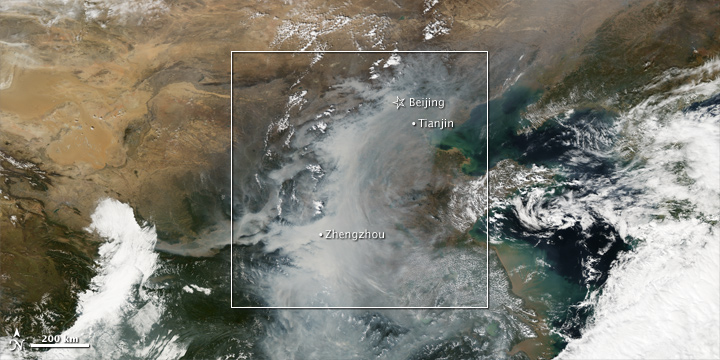
This spectacular cloud of smog and haze formed over eastern China last week when a high-pressure weather system moved in to the area, allowing industrial and burning byproducts to settle with little disturbance from winds. As NASA’s Earth Observatory reported, NASA satellite instruments detected extremely high levels of sulfur dioxide, which most likely came from various industrial processes such as coal-burning power plants and smelters (facilities that melt or fuse ores in order to extract usable metals).
Satellites also detected high levels of aerosols — most likely sooty black carbon or organic carbon particles from wildfires and fossil fuel burning – that absorb sunlight and “trap” heat. In fact, the air was so thick with the light-absorbing particles at times that seeing the midday sun clearly would have been difficult. Bearing this out, news media reported numerous traffic accidents associated with the lack of visibility.
How does this event fit into broader pollution trends in the region? A study published earlier this year in Atmospheric Chemistry and Physics offers some insight. The authors, which included a researcher from Goddard Space Flight Center, analyzed sulfur dioxide emission trends in China since 2000 and made a number of notable observations. These included:
- From 2000 to 2006, total sulfur dioxide emissions in China increased by 53 percent from 21.7 teragrams to 33.2 teragrams, an annual growth rate of 7.3 percent per year.
- Geographically, emissions from northern China increased by 85 percent whereas emissions from the south increased by only 28 percent.
- However, emissions started to decline in 2006, primarily due to the wide application of flue-gas desulfurization (FGD) devices in power plants.
Want more details? You can read the full paper here [PDF].
–Adam Voiland, NASA’s Earth Science News Team, Image courtesy of NASA’s Earth Observatory

Air is rare strange.
Power is Air, progress is the consequence of Air.
But rather possible is contamination if we breath.
What is then… contamination in general???
Considering that imparcial Air is Air only.